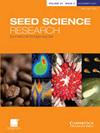采用非线性回归和时间-事件模型对截尾数据进行应急速度比较
IF 1.9
3区 生物学
Q2 PLANT SCIENCES
引用次数: 0
摘要
在种子技术领域的实验中,确定发芽速度是必不可少的,因为它允许对种子批次进行性能评估和建立预测模型。为此,文献提出了几种方法和指标。本研究的目的是比较种子出苗速度分析的主要方法,即非线性回归模型和出苗速度指数(ESI)与事件时间模型。本研究以桃棕种子(Bactris gasipaes)为研究对象,在4个月的时间里,通过每日评估来测定其活力和活力。通过种子出苗速度量化评价活力,采用ESI、非线性回归和考虑发芽作为事件时间的非线性回归三种方法。结果表明,ESI不是评价应急速度的良好指标;非线性回归模型低估了误差,从而增加了错误分类治疗的概率;时间-事件模型在根据出现速度对处理进行分类时更可靠。本文章由计算机程序翻译,如有差异,请以英文原文为准。
Emergence speed comparison by non-linear regression and approached by time-to-event models for censored data
Abstract Determining the germination speed is essential in experiments in the field of seed technology, as it allows the performance evaluation of a seed lot and the creation of predictive models. To this end, the literature addresses several methods and indexes. The objective of this study was to compare the main methods of emergence speed analysis in seeds, namely the non-linear regression models and the Emergence Speed Index (ESI), with the time-to-event models. The research was conducted with peach palm seeds (Bactris gasipaes) that were measured for viability and vigour through daily evaluations for 4 months. Vigour was evaluated by the quantification of the seed emergence speed, which was performed in three ways: ESI, non-linear regression and non-linear regression considering germination as a time-to-event event. From the results obtained, we conclude that the ESI is not a good indicator to evaluate the emergence speed; the non-linear regression model underestimates the errors and, thus, increases the probability of misclassifying treatments; the time-to-event model is more reliable in classifying treatments according to the emergence speed.
求助全文
通过发布文献求助,成功后即可免费获取论文全文。
去求助
来源期刊

Seed Science Research
生物-植物科学
CiteScore
3.60
自引率
4.80%
发文量
23
审稿时长
>12 weeks
期刊介绍:
Seed Science Research, the official journal of the International Society for Seed Science, is a leading international journal featuring high-quality original papers and review articles on the fundamental aspects of seed science, reviewed by internationally distinguished editors. The emphasis is on the physiology, biochemistry, molecular biology and ecology of seeds.
 求助内容:
求助内容: 应助结果提醒方式:
应助结果提醒方式:


